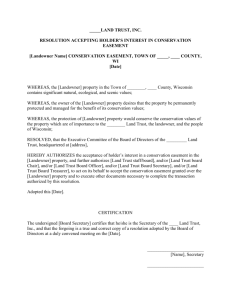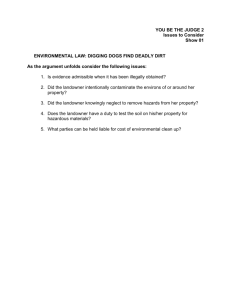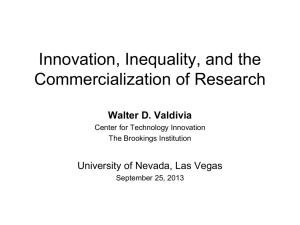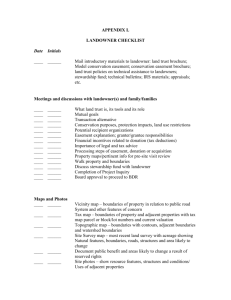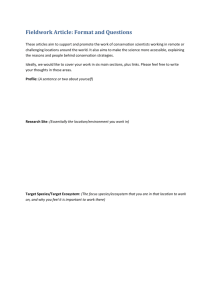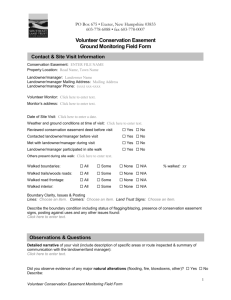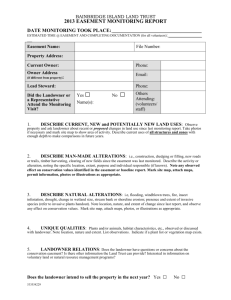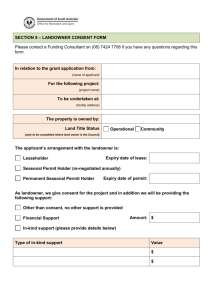Baseline Documentation Report - Conservation Easements in Alberta
advertisement
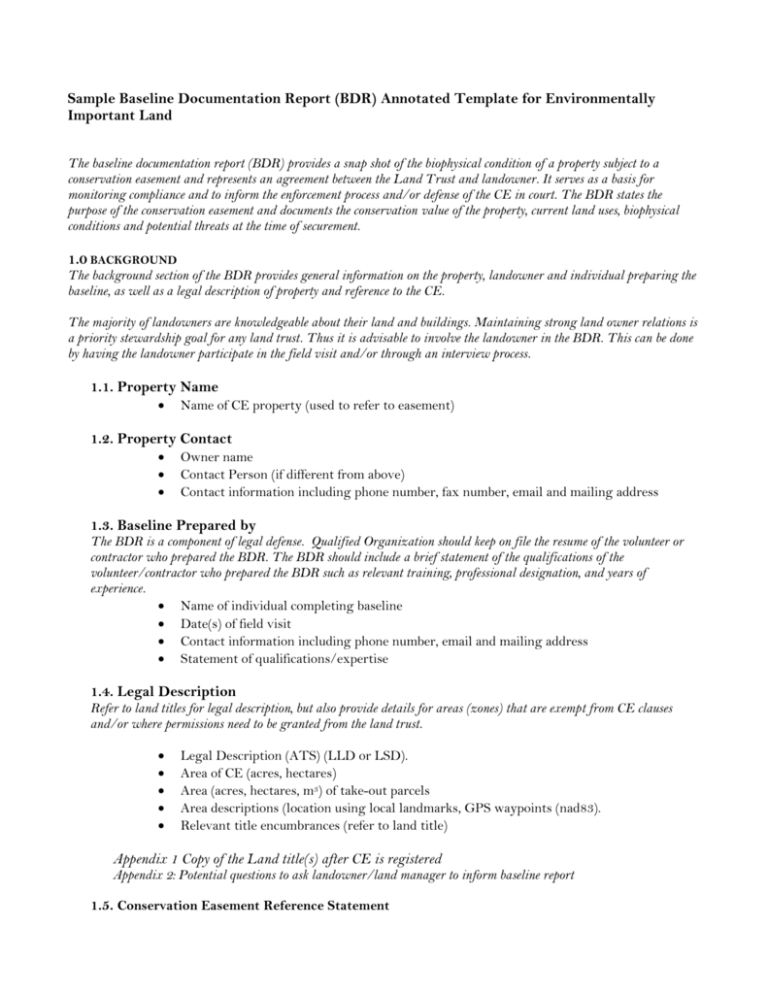
Sample Baseline Documentation Report (BDR) Annotated Template for Environmentally Important Land The baseline documentation report (BDR) provides a snap shot of the biophysical condition of a property subject to a conservation easement and represents an agreement between the Land Trust and landowner. It serves as a basis for monitoring compliance and to inform the enforcement process and/or defense of the CE in court. The BDR states the purpose of the conservation easement and documents the conservation value of the property, current land uses, biophysical conditions and potential threats at the time of securement. 1.0 BACKGROUND The background section of the BDR provides general information on the property, landowner and individual preparing the baseline, as well as a legal description of property and reference to the CE. The majority of landowners are knowledgeable about their land and buildings. Maintaining strong land owner relations is a priority stewardship goal for any land trust. Thus it is advisable to involve the landowner in the BDR. This can be done by having the landowner participate in the field visit and/or through an interview process. 1.1. Property Name Name of CE property (used to refer to easement) 1.2. Property Contact Owner name Contact Person (if different from above) Contact information including phone number, fax number, email and mailing address 1.3. Baseline Prepared by The BDR is a component of legal defense. Qualified Organization should keep on file the resume of the volunteer or contractor who prepared the BDR. The BDR should include a brief statement of the qualifications of the volunteer/contractor who prepared the BDR such as relevant training, professional designation, and years of experience. Name of individual completing baseline Date(s) of field visit Contact information including phone number, email and mailing address Statement of qualifications/expertise 1.4. Legal Description Refer to land titles for legal description, but also provide details for areas (zones) that are exempt from CE clauses and/or where permissions need to be granted from the land trust. Legal Description (ATS) (LLD or LSD). Area of CE (acres, hectares) Area (acres, hectares, m3) of take-out parcels Area descriptions (location using local landmarks, GPS waypoints (nad83). Relevant title encumbrances (refer to land title) Appendix 1 Copy of the Land title(s) after CE is registered Appendix 2: Potential questions to ask landowner/land manager to inform baseline report 1.5. Conservation Easement Reference Statement Refer back to the CE (may include the date CE was signed) and provide a brief history of donation of CE, indicate if CE is donation, split receipt, paid and/or an Ecological Gift under Environment Canada’s Ecological Gift Program. Provide a reference to the conservation easement agreement, Date it was signed, Description of donation/acquisition of property. 1.6 Partnership Approach Describe the link between the qualified organization’s conservation objectives and the land owner’s interest in placing a CE on the property. If available attach the Letter of Intent from the landowner 2.0 PURPOSE OF CE The purpose of the CE states the intent of the conservation easement and the common purpose of the CE from the landowner and land trust perspectives. In this section, regional and local conservation values that the CE protects are highlighted. There is debate around focusing the purpose on regional or local conservation values, because of instances whereby documentation is considered either too vague or too specific in describing the purpose. Clarity is important when describing the conservation value and a land trust needs to consider landscapes as dynamic entities and that a CE is for perpetuity. For example, describing the purpose of a CE in protecting habitat for an endangered species could be problematic in court if the species becomes extirpated from the region. In addition, the language linking the CE and BDR must be consistent. The reader of the BDR should understand the reason the landowners and qualified organization have entered into a CE. For example, is there a common purpose or shared conservation values? Attaching a letter of intent from the landowner and referring to the qualified organization’s mission statement, if appropriate, will help readers to understand the intent of the CE. 2.1 Regional Context A regional context will be provided by highlighting the general conservation values (e.g. species at risk, ecological systems/landscapes of interest, Ecologically Significant Areas) of the property in relation to the other similar features in the municipality and lands adjacent and/or nearby the CE (e.g. other government or privately protected lands). 2.2 Local Context Highlight specific natural features of the landscape, including any specific sensitive ecosystem types or features found on the property. Insert Map 1 – Surrounding context - include roads, rivers and streams, protected areas, other parcels of interest (as detailed in regional context) 3.0 Anthropogenic Features and Land Use Activities A BDR documents the current condition of the land at the time of signing. To monitor for compliance, all anthropogenic features occurring on the CE property will be documented. This section will be tied into the CE restrictions and will include a list of features or activities to be grandfathered into the CE. If a planned feature does not yet exist on the property, it should be stated as such in the BDR. All features will be mapped and photographed to provide clarity to the baseline and the purpose of the structures will be explained. 3.1 Existing Anthropogenic features (Grandfathered into CE) Provide a written description (include purpose of feature), map (UTM (using GPS unit) and photograph (include UTM (using GPS unit) of photo, direction of photo (using compass directions) and photo description) all existing human made features on the landscape. Some features to consider based on restrictions; o All building structures and associated infrastructure o Fences (record height and number of wire strands) o Roads and Trails o Soil disturbance (cleared areas) o Mining (sand, rock, gravel piles) o Existing oil and gas infrastructure o Garbage, waste or debris sites o Water systems (irrigation, troughs, wells, dugouts) o Wildlife traps o Areas where chemicals ( pesticides, fertilizers and herbicides) have been applied o May need to consider other features as well depending on specifics of the CE and the property Map 2 – Anthropogenic Features- location within CE of features described above 3.2 Land Use Activity To enable the land trust to assess the level of risk on a property, the BDR will describe the historic and current land uses on the property and on neighboring parcels. For example, are there any areas on or near the property that may be zoned for conflicting activities that might put the conservation values of the property at risk? Does the landowner have existing management plans in place to guide land management (e.g. forestry, grazing)? All current management plans being used by the landowner will be documented. The BDR can inform and guide the development of any future management plans for the property. Describe historical (if relevant) and current land use activities for the CE and specified areas if applicable. Current zoning. Refer to existing management plans. Highlight land use activities on surrounding parcels. Appendix 3 Existing Management Plans for Property Appendix 4: Photo table of locations, map and photos 4.0 Natural Features All water features should be identified by type (river, stream, pond, lake, and wetland), mapped and photographed. Note if the water features are ephemeral or year round, direction of flow, and activities up stream that may impact health. CE clauses that refer to the health or condition of water features may be difficult to measure. The land trust needs to develop protocols for how it will determine if this clause is in compliance. 4.1 Hydrological Features Provide a written description, map (UTM (using GPS unit) and photograph (UTM (using GPS unit), direction of photo (using compass) and photo description) all existing water features on the CE. Water features may include: o Rivers, streams o Water bodies (lakes, ponds, wetlands) o Springs 4.2 Water Quality Note activities occurring on the CE that may impact water health? o Wildlife / stock watering o Trails / roads through water systems o Proximity to an agricultural field o Recreational use o Chemical usage o Wildlife presence / absence Water sampling approaches o Water samples will be taken where a stream enters and exits the property to generate a baseline of water quality. Future monitoring of the effect of activities will refer to the baseline. Map 4 – Water Features- location within CE of features described above 4.2 Vegetation Vegetation communities should be documented on map, with photos and described in the BDR. In addition, threats to the native vegetation should be documented (e.g. invasive species). Provide a written description (include dominant species, rare and unusual flora, human – made habitat), map (UTM (using GPS unit) and photograph (UTM (using GPS unit), direction of photo (using compass) and photo description) all vegetation communities including natural and human-made on the CE. Common types of vegetation communities include native grassland, wetland, riparian, croplands, tame forage, aspen and spruce forest. (May be able to use remote sensing or Alberta Vegetation Index or Alberta Plant Community Guides as a starting point). Document threats to native vegetation communities. Describe and list invasive species occurring on the CE (document larger patches on map, using UTM (GPS Unit). Map 5 – Vegetation Communities - location within CE of features described above 4.3 Surficial Bedrock Geology and Soils Identify surface and underlying geology Use AGRISID to determine soil series Map 6 – Soil Series 4.3 Wildlife In this section of the BDR describe important wildlife habitat (e.g. ungulate winter range, grizzly bear movement corridor), species of interest or any other ecological values. Include in this section rare, endangered species (including rank) that may occur on the property. This section may reply heavily on landowner knowledge, local expert knowledge (local fish and wildlife officers, biologists) or research reports. List specific habitat occurring on the property for terrestrial or aquatic species and/or species groups of interest List any important migrating species that use the property as permanent or seasonal habitat or for movement opportunities for specific groups and or species? Reference other research/reports that document the importance of this area for species groups and/or species. List any rare or endangered species occurring on the property. Specify rank and if recovery plan is in place. Appendix 3: Photo table of locations, map and photos 5.0 Monitoring Recommendations A BDR should include a series of recommendations about how to monitor the property and to help inform the management plan. List any recommendations for future monitoring (e.g. invasive species of concern, addressing threats outlined in the BDR). Time of year for monitoring to occur. How often monitoring should occur Frequency of using certain types of field methodologies if appropriate to CE clauses or existing management plan (e.g. range health, riparian health) 6.0 Owner Acknowledgement of Condition Include a section for signatures, where the qualified organization and landowners agree to the BDR as accurately representing the current condition of the property. Date of completion. Appendix 1: Land Title Appendix 2: Landowner Interview –suggested questions to inform BDR a. Length of time as owner of property b. Existing land uses of property (also historical if different) e.g. agriculture, ranching, recreation and forestry) c. Current management regime (Are there any management plans?). d. Are there areas/topics you feel you would like to know more about? e. Discuss anthropogenic features on the landscape and purpose of features. f. Discuss water features on the landscape – location of features g. Do you have invasive species on the property (list species if possible) and discuss location of patches. As well as history (eg. pathways of invasion) h. Are you aware of any water quality assessments on this property? Are you interested in learning more about water health issues? i. Are there areas where chemical pesticides or fertilizers have been used on the property? If yes, please explain why? j. Please list species you have seen on the property and frequency of sightings? k. Are there things you are concerned about from a stewardship perspective that we might be able to assist you with? Appendix 3: Photo Location table, map and photos (with description) Photo # UTM East UTM West Map 7 – Photograph locations Date Prepared by Miistakis Institute for Foothills Land Trust With support from Alberta Real Estate Foundation and The Calgary Foundation Disclaimer This Baseline Documentation Report Template was created for the Foothills Land Trust and may or may not be appropriate for all land trust organizations. It is available for any land trust to use and to adapt for its own purposes. Foothills Land Trust is not responsible for any results achieved or decisions made through the use of the Baseline Documentation Report Template.
